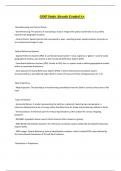Examen
GISP Study Already Graded A+
- Cours
- Établissement
GISP Study Already Graded A+ Georeferencing and Control Points - Georeferencing: The process of associating a map or image with spatial coordinates to accurately represent its geographic location. - Control Points: Specific points that correspond in pairs, matching known spatial locations to po...
[Montrer plus]



